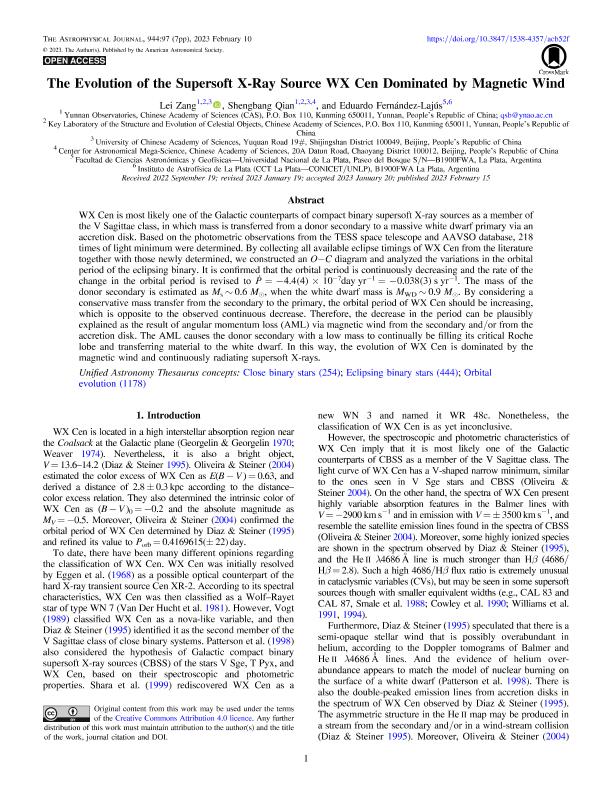Mostrar el registro sencillo del ítem
dc.contributor.author
Zang, Lei
dc.contributor.author
Qian, Shengbang
dc.contributor.author
Fernandez Lajus, Eduardo Eusebio

dc.date.available
2024-04-17T15:43:48Z
dc.date.issued
2023-02
dc.identifier.citation
Zang, Lei; Qian, Shengbang; Fernandez Lajus, Eduardo Eusebio; The Evolution of the Supersoft X-Ray Source WX Cen Dominated by Magnetic Wind; IOP Publishing; Astrophysical Journal; 944; 1; 2-2023; 1-7
dc.identifier.issn
0004-637X
dc.identifier.uri
http://hdl.handle.net/11336/233343
dc.description.abstract
WX Cen is most likely one of the Galactic counterparts of compact binary supersoft X-ray sources as a member of the V Sagittae class, in which mass is transferred from a donor secondary to a massive white dwarf primary via an accretion disk. Based on the photometric observations from the TESS space telescope and AAVSO database, 218 times of light minimum were determined. By collecting all available eclipse timings of WX Cen from the literature together with those newly determined, we constructed an O-C diagram and analyzed the variations in the orbital period of the eclipsing binary. It is confirmed that the orbital period is continuously decreasing and the rate of the change in the orbital period is revised to P˙=−4.4(4)×10−7dayyr−1=−0.038(3)syr−1�˙=−4.4(4)×10−7dayyr−1=−0.038(3)syr−1 . The mass of the donor secondary is estimated as M s ~ 0.6 M ⊙, when the white dwarf mass is M WD ~ 0.9 M ⊙. By considering a conservative mass transfer from the secondary to the primary, the orbital period of WX Cen should be increasing, which is opposite to the observed continuous decrease. Therefore, the decrease in the period can be plausibly explained as the result of angular momentum loss (AML) via magnetic wind from the secondary and/or from the accretion disk. The AML causes the donor secondary with a low mass to continually be filling its critical Roche lobe and transferring material to the white dwarf. In this way, the evolution of WX Cen is dominated by the magnetic wind and continuously radiating supersoft X-rays.
dc.format
application/pdf
dc.language.iso
eng
dc.publisher
IOP Publishing

dc.rights
info:eu-repo/semantics/openAccess
dc.rights.uri
https://creativecommons.org/licenses/by/2.5/ar/
dc.subject
Close binary stars
dc.subject
Eclipsing binary stars
dc.subject
Orbital evolution
dc.subject.classification
Astronomía

dc.subject.classification
Ciencias Físicas

dc.subject.classification
CIENCIAS NATURALES Y EXACTAS

dc.title
The Evolution of the Supersoft X-Ray Source WX Cen Dominated by Magnetic Wind
dc.type
info:eu-repo/semantics/article
dc.type
info:ar-repo/semantics/artículo
dc.type
info:eu-repo/semantics/publishedVersion
dc.date.updated
2024-04-17T13:10:05Z
dc.journal.volume
944
dc.journal.number
1
dc.journal.pagination
1-7
dc.journal.pais
Reino Unido

dc.description.fil
Fil: Zang, Lei. Chinese Academy of Sciences; República de China
dc.description.fil
Fil: Qian, Shengbang. Chinese Academy of Sciences; República de China
dc.description.fil
Fil: Fernandez Lajus, Eduardo Eusebio. Consejo Nacional de Investigaciones Científicas y Técnicas. Centro Científico Tecnológico Conicet - La Plata. Instituto de Astrofísica La Plata. Universidad Nacional de La Plata. Facultad de Ciencias Astronómicas y Geofísicas. Instituto de Astrofísica La Plata; Argentina
dc.journal.title
Astrophysical Journal

dc.relation.alternativeid
info:eu-repo/semantics/altIdentifier/url/https://iopscience.iop.org/article/10.3847/1538-4357/acb52f
dc.relation.alternativeid
info:eu-repo/semantics/altIdentifier/doi/http://dx.doi.org/10.3847/1538-4357/acb52f
Archivos asociados
